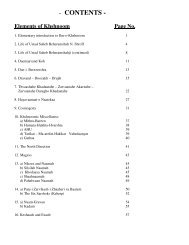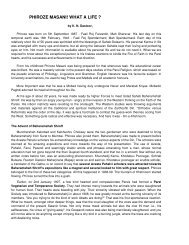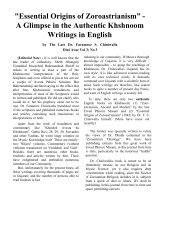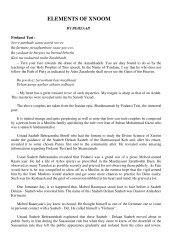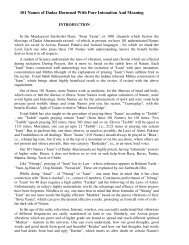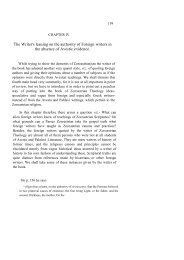Acceptance – Never Ever. - Traditional Zoroastrianism: Tenets of the ...
Acceptance – Never Ever. - Traditional Zoroastrianism: Tenets of the ...
Acceptance – Never Ever. - Traditional Zoroastrianism: Tenets of the ...
You also want an ePaper? Increase the reach of your titles
YUMPU automatically turns print PDFs into web optimized ePapers that Google loves.
Chapter 8<br />
HISTORICAL EVIDENCE REFUTES CONVERSION<br />
It's a pity that some latter-day Parsee charlatans, who don <strong>the</strong> garb <strong>of</strong> scholarship, tell us that it<br />
is only after coming to India that <strong>the</strong> Parsees refused to accept converts to <strong>the</strong>ir religion, because, as<br />
Justice Beaman summed up, "Those who reached India were a scattered remnant. They were only too<br />
glad to receive an asylum to be allowed to live in peace and pr<strong>of</strong>ess <strong>the</strong>ir ancient faith. In such<br />
circumstances, <strong>the</strong> idea <strong>of</strong> proselytism was impolitic and impracticable. They had enough to do to<br />
preserve <strong>the</strong>ir own faith, <strong>the</strong>ir own little society, against <strong>the</strong> impact <strong>of</strong> great surrounding forces, … .. .<br />
religious and social".<br />
This, at best, is a good surmise. No one, not even <strong>the</strong> best <strong>of</strong> Iranian scholars, whe<strong>the</strong>r<br />
Oriental or Western, has adduced any evidence in <strong>the</strong> last 200 years that in ancient Zoroastrian Iran,<br />
conversion or proselytism was common or rampant. How could <strong>the</strong>y, when <strong>the</strong> Zoroastrian Religion,<br />
based on <strong>the</strong> Divine law <strong>of</strong> Asha, forbade conversion? And it should be remembered that <strong>the</strong> history<br />
<strong>of</strong> Zoroastrian Iran straddled a period <strong>of</strong> thousands <strong>of</strong> years !<br />
On <strong>the</strong> contrary, it can be easily proved that <strong>the</strong> mighty powerful Iranian Zoroastrian Kings<br />
and paladins never resorted to conversion <strong>of</strong> non-Zoroastrians, ei<strong>the</strong>r by force or persuasion. Just two<br />
examples will suffice. One is <strong>the</strong> famous instance <strong>of</strong> King Cyrus <strong>the</strong> great <strong>of</strong> <strong>the</strong> Achemenian Empire.<br />
The Babylonian King Nebuchadnezzar (604-562 B.C.) had united <strong>the</strong> countries <strong>of</strong> <strong>the</strong><br />
Assyrians, <strong>the</strong> Aramaics and <strong>the</strong> Phoenecians, living in ancient Mesopotamia. He had conquered<br />
Jerusalem, destroyed <strong>the</strong> city, demolished <strong>the</strong> famous Temple <strong>of</strong> Solomon and kept <strong>the</strong> Jews in<br />
captivity in Babylonia. The last Babylonian king was Nabunaid, who was an ally <strong>of</strong> Croesus, <strong>the</strong> king<br />
<strong>of</strong> Lydia. Nabunaid, however, was not popular in his country. When Cyrus marched into Babylonia,<br />
people opposed Nabunaid, opened <strong>the</strong> city gates, and received Cyrus as <strong>the</strong>ir deliverer (539 B. C.).<br />
If Cyrus wanted, he could have easily subjugated <strong>the</strong> conquered people. Instead, he allowed<br />
<strong>the</strong>m to rule <strong>the</strong>ir countries, and follow <strong>the</strong>ir religion. Cyrus not only delivered <strong>the</strong> Jews from<br />
captivity in Babylon, but even helped <strong>the</strong>m to rebuild <strong>the</strong> Temple <strong>of</strong> Solomon. For this act <strong>of</strong><br />
magnanimity, Cyrus is considered a Messiah, "<strong>the</strong> anointed <strong>of</strong> <strong>the</strong> Lord" (Isaiah 45.1). Incidentally,<br />
references to Cyrus in this vein, can be found besides Isaiah, in <strong>the</strong> Old Testament, in Ezra 1.1-2;<br />
Ezra 6.3-4 and Ezra 6.14-15.<br />
Again, it is historically recorded that both during <strong>the</strong> Achaemenian times and in <strong>the</strong> preceding<br />
period <strong>of</strong> <strong>the</strong> Medians, <strong>the</strong>re were many idol-worshipping faiths and cults practised by <strong>the</strong> non-<br />
Zoroastrian people. However, what's noteworthy is that, each community considered <strong>the</strong> o<strong>the</strong>r<br />
community's cult and idols superior to its own! The result was that <strong>the</strong>y would fight among<br />
<strong>the</strong>mselves to borrow such cults <strong>of</strong> <strong>the</strong> o<strong>the</strong>rs ! They never went to war trying to impose or force <strong>the</strong>ir<br />
faith on o<strong>the</strong>rs, i.e. <strong>the</strong>y never tried to convert o<strong>the</strong>rs to <strong>the</strong>ir faith ! Such evidence is to be found in<br />
some <strong>of</strong> <strong>the</strong> extant Assyrian records. Thus, <strong>the</strong>re was always an attraction between faith and faith, cult<br />
and cult and not antagonism or hatred between <strong>the</strong>m. It was only after Judaism found its proper roots<br />
and entrenched itself in certain parts <strong>of</strong> <strong>the</strong> world that, for <strong>the</strong> first time, wars were fought between<br />
<strong>the</strong> Greeks and <strong>the</strong> Jews, each considering his creed to be superior to <strong>the</strong> o<strong>the</strong>r ! One such example is<br />
given above, when <strong>the</strong> Babylonian Nebuchadnezzar defeated <strong>the</strong> Jews and held <strong>the</strong>m in captivity till<br />
<strong>the</strong> Achaemenian Zoroastrian king, Cyrus, delivered <strong>the</strong>m from captivity.<br />
17





